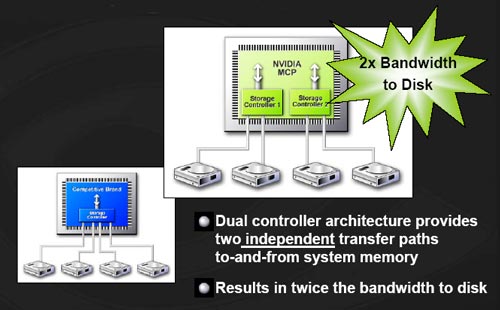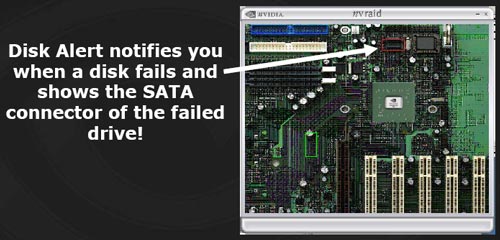nForce4: PCI Express and SLI for Athlon 64
by Wesley Fink on October 19, 2004 12:01 AM EST- Posted in
- CPUs
3Gb/s SATA
nVidia pioneered "any drive" integrated RAID capabilities with the nForce3-250 chipset. This included support for 4 SATA drives and 4 PATA drives that could be combined in RAID 0, 1, and 0+1 configurations. For nForce4, nVidia has taken SATA support even further by providing two independent SATA controllers on the nForce 4 Ultra and nForce4 SLI chipsets.
The Dual SATA controllers on the nF4 also support the upcoming 3Gb/sec SATA drives, which are now sampling. The new 3Gb/s SATA drives should start appearing in the market around the end of the year, which will provide nForce4 users with an upgrade path to improved hard drive performance. The nForce4 also supports drives with NCQ (Native Command Queuing).
Cross-Controller RAID
The unique cross-controller RAID is continued in the nForce4 chipset. This means that both Serial ATA (SATA) and parallel ATA disk devices can be combined within a single RAID array. Users don't need to worry about whether hard drives are SATA or IDE - the nVidia RAID controller treats both IDE and SATA drives the same and allows them to be combined in any way in the RAID controller. A single setup procedure applies to all drives, which makes it possible to use all the storage devices available. Users can also expand the number of drives easily without worrying about whether the drive is IDE or SATA.Spare Disk Allocation
Corporate RAID users are accustomed to RAID arrays with "hot spares" and on-the-fly rebuilds, but those RAID 5 features have been an expensive addition to a home PC. If a disk fails, RAID 1 allows continuous operation by taking advantage of the mirrored data copy in the array. The nVidia RAID solution goes a step further and lets a user rebuild a new mirrored copy for the data while the system is up and running, without disrupting user and application access to the data set. Rebuilding on the fly eliminates down time and maximizes protection for critical storage resources.The nVidia RAID controller allows the user to add hot spare features to a home PC that is running any type of mirroring on the nVidia RAID controllers. Users can designate spare drives that can be configured as hot standbys, protecting arrays in the event of a disk failure. A shared spare can protect multiple arrays of drives, or a dedicated spare can serve as a hot standby for a particular drive array. The spare disk feature, which offers protection that goes beyond mirroring data, has been traditionally limited to high-end RAID systems, but this feature is built into the nForce4 RAID controllers. This isn't RAID 5 on a home PC, but the flexibility and data protection capabilities are truly impressive.
Disk Alert
One of the clever options available with the nForce4 is a feature called Disk Alert. With the large number of drives supported on the nForce4, it is not always an easy task to determine which drive has failed in the event of a pulled cable or other drive problem.
Disk Alert pops up a picture of the motherboard and shows exactly which drive connection has failed. This is a really slick idea, but we are still dependent on motherboard manufacturers to supply an accurate picture or diagram to embed in the alert feature.
Morphing From One RAID Array to Another
Morphing is the ability to convert from one RAID mode to another RAID mode. This allows the user to upgrade their current disk or array for better performance, higher security, and increased capacity. More importantly, this is accomplished without having to go through multiple steps. The morphing feature gives the user an upgradeable option to manage storage easily.In a traditional RAID environment, when a user wants to change the current state of a disk or a current array to a new RAID configuration, reconfiguring the new array involves a number of steps. The user must back up the data, delete the array, re-boot the PC, and then reconfigure the new array. NVIDIA RAID allows the end user to change the current state of the disk or array to another with a one-step process called "Morphing".
In general, to morph a RAID, the new array capacity must be equal to or greater than the previous array. For example, it is possible to morph from a RAID 1 array to a RAID 0 array as long as the RAID 0 array is the same size as (or larger than) the RAID 1 array. There are some limitations to RAID morphing, however. You can't morph to or from a JBOD (Spanning) array, from RAID 1 to RAID 1, or from RAID 0+1 to RAID 1.










101 Comments
View All Comments
Zac42 - Tuesday, October 19, 2004 - link
I think that it has to be two Nvidia cards with an SLI connector. You are thinking of the alienware video array, which theoretically can use two different branded cards.GhandiInstinct - Tuesday, October 19, 2004 - link
Wesley,So in SLI, I can put any two video cards together? No matter the spec difference or maker difference? New and old? Future and past?
microAmp - Tuesday, October 19, 2004 - link
I take it the SLI benchmarks from nVidia were done at about 1600 x 1200 resoultion?Wesley Fink - Tuesday, October 19, 2004 - link
Kris -Anand and I got some hands-on time with the SLI system while we were visiting nVidia. The benchmarks we ran confirmed the numbers reported for the 6800 Ultra single and SLI. The test system was an Asus SLI motherboard with a 4000+ CPU. While we did not personally run benchmarks with the 6600GT SLI or the 6800GT SLI we have no reson to doubt nVidia's numbers based on what we did confirm.
The Reference board is NOT SLI, which is why SLI testing was limited to our time with nVidia.
KristopherKubicki - Tuesday, October 19, 2004 - link
#6 those are NVIDIA's benchmarks, not actual 3rd party confirmed benchmarks.Kristopher
Wesley Fink - Tuesday, October 19, 2004 - link
#2 and #4 -SLI Performance tests are in a table on page 3. Two 6600GTs don't outperform a 6800 Ultra, but they do outperform a 6800 GT.
ksherman - Tuesday, October 19, 2004 - link
#4, from what ive heard, it is probablyh likely that two 6600GTs would definetly cream the 6800 ultra. I do agree that we need some SLI benchies!!!ariafrost - Tuesday, October 19, 2004 - link
*Drool* Anyone know how much of a performance boost would come from SLI yet? I'm wondering if two 6600GTs would outperform a 6800 ultra.glennpratt - Tuesday, October 19, 2004 - link
Page 2"While nVidia was not ready to ship nForce4 SLI reference boards for review, they were demonstrating a major manufacturer's nF4 SLI board with a pair of nVidia 6800 Ultra video cards. We also got to play with the SLI system with an Athlon 64 4000+ CPU, confirming benchmarks that were supplied by nVidia."
Jincuteguy - Tuesday, October 19, 2004 - link
why didn't anand did any SLI performance test? i thoguht this board suppose to have SLI.